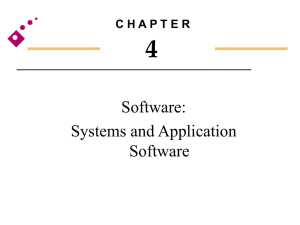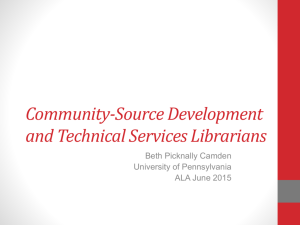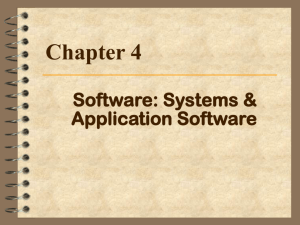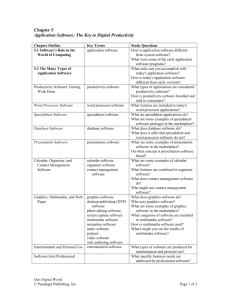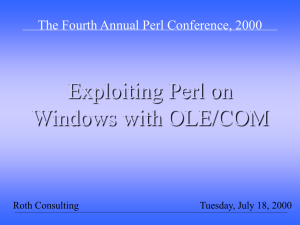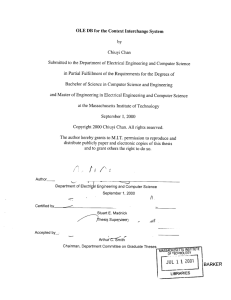Systems and Applications Software
advertisement
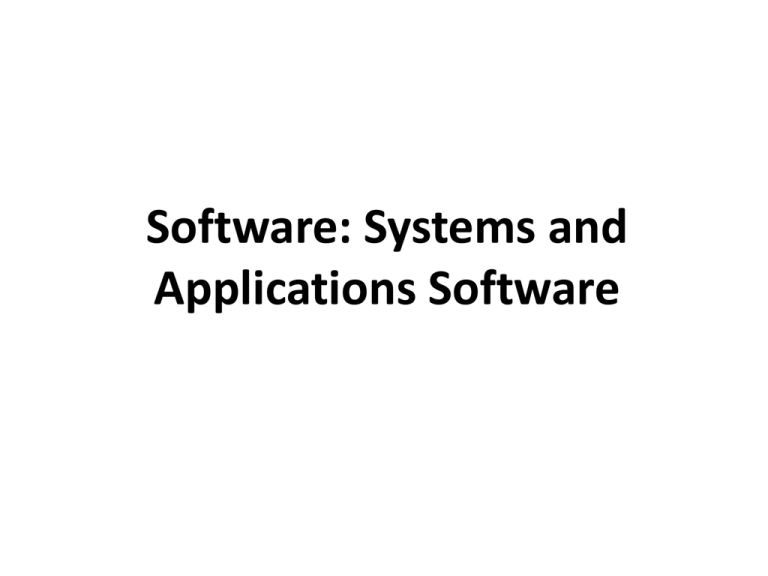
Software: Systems and Applications Software The Importance of Software in Business High Software $ Hardware Low 1950 time today Classes of Software • Systems software – Set of programs that coordinates activities and functions of the hardware and various other programs • Application software – Programs that help users solve particular computing problems Types of Application Software • Proprietary – Designed to solve a unique and specific problem • In-house – Development of application software using the company’s resources • Contract – Developed for a particular company • Off-the-shelf – An existing software program that can be used without considerable changes expected Sources of Software • Customized package – Blend of external and internal software development • In-house customized • Contract customization Application software Proprietary software In-house developed Off-the-shelf software Standard package Customized package Contract In-house customized Contract customization Examples Turbo Tax Turbo Tax Provides automated assistance for tax preparation and submission. (Figure 4.6) 24 Quicken Quicken An off-the-shelf software package that provides assistance for standard check writing and personal accounting. (Figure 4.7) 25 Word Processing Word Processing Provides assistance in formulating, formatting, and printing documents such as letters, memos, and papers. (Figure 4.8) 26 Spreadsheet Spreadsheet Provides a wide range of built-in functions for statistical, financial, logical, database, graphics, and data and time calculations. (Figure 4.9) 27 Database Database Stores, manipulates, and retrieves data. (Figure 4.10) 28 Graphics Graphics Program Helps make a presentation; develops brochures, illustrations, etc. Usually called Presentation Graphics On-Line Services (Figure 4.12) On-Line Services Provide access to various information resources. (Figure 4.12) 30 Software Suite Software Suite Collection of personal productivity software such as word processor, spreadsheet, and database. 31 Software Concepts - OLE • OLE = Object Linking and Embedding – A software feature that allows you to copy text from one document to another or embed graphics from one program into another program or document – Server Application – The application that supplies objects you place into other applications • Client application – The application that accepts objects from other applications OLE Concepts • Copy – Copy data from one application and place it in another • Link – Changes made to the server object to automatically appear in all linked client objects • Embed – An object to become part of the client document Graphics Program Server Application Client Application Word Processing Program Team photo Copy Spreadsheet Program Server Application Actual vs. Budget -------------------------------------Team photo Actual vs. budget Link --- --- --- --- --- --- --- -- --- - - - --- --- --- --- --- --- -- Project Management Program Server Application Chart ==== == == == == == = === == == ==== ==== = Chart ------------------- -------- Embed OLE ‘Discussion’ Abbreviation for Object Linking and Embedding, pronounced as separate letters or as oh-leh. OLE is a compound document standard developed by Microsoft Corporation. It enables you to create objects with one application and then link or embed them in a second application. Embedded objects retain their original format and links to the application that created them. Support for OLE is built into the Windows and Macintosh operating systems. A competing compound document standard developed jointly by IBM, Apple Computer, and other computer firms is called OpenDoc. Enterprise Application Software • Enterprise application software… – Software that benefits the entire organization – Examples Accounts receivable Accounts payable Cash-flow analysis Manufacturing control General Ledger Sales ordering Order entry Check processing Receiving Retail Operations Example Integrated Supply Chain Management Software Enterprise Resource Planning (ERP) • Enterprise Resource Planning (ERP)… – A set of integrated programs that manage a company’s vital business operations for an entire multi-site, global organization – Vendor examples SAP Oracle PeopleSoft Dun & Bradstreet QAD JD Edwards Baan SSA Marcam Ross Systems ERP ‘Discussion’ Short for enterprise resource planning, a business management system that integrates all facets of the business, including planning, manufacturing, sales, and marketing. As the ERP methodology has become more popular, software applications have emerged to help business managers implement ERP. Programming Languages • Programming languages… – Coding schemes used to write both systems and application software Categories of Programming Languages (1) • Machine Language – 1st generation programming language – Considered a low-level language because it involves basic coding using the binary symbols 1 and 0 • Assembly Language – 2nd generation language – Replaced binary digits with mnemonics (e.g., “ADD”) programmers could more easily understand Categories of Programming Languages (2) • Third Generation Languages – Continued trend to more symbolic code (e.g. COBOL) • Fourth Generation Languages (4GLs) – Languages that are less procedural and even more English-like than third-generation languages (e.g. FOCUS) Categories of Programming Languages (3) • Query languages – Used to ask the computer questions in English-like sentences – Also known as database languages • Structured query language (SQL) – A standardized language often used to perform database queries and manipulations Object Oriented Languages (1) • Object-oriented languages (OOL) • Languages that allow interaction of programming objects, including data elements and the actions that will be performed on them • Note: OOP = object-oriented programming • Encapsulation • The process of grouping items into an object • Polymorphism • A process allowing the programmer to develop one routine or set of activities that will operate on multiple objects Object Oriented Languages (2) • Inheritance • Property used to describe objects in a group of objects taking on characteristics of other objects in the same group or class of objects • Reusable code • The instruction code within an object that can be reused in different programs for a variety of applications • Examples • Smalltalk, C++, Java Visual Programming Languages • Visual programming languages… – Languages that use a mouse, icons, or symbols on the screen and pull-down menus to develop programs – Examples • Visual Basic • Visual C++ • PC COBOL Fifth-Generation Languages • 5th generation languages… – Combines rule-based code generation, component management, visual programming techniques, and reuse management – Knowledge-based management • An approach to the development of computer programs in which you do not tell a computer how to do a job, but what you want it to do Programming Languages: Terminology (1) • Language translator – Systems software that converts a programmer’s source code into its equivalent in machine language • Source code – High-level program code written by the programmer • Object code – Another name for machine language code Programming Languages: Terminology (2) • Interpreter – A language translator that translates one program statement at a time into machine code Program statement Interpreter Machine language statement Statement execution Programming Languages: Terminology (3) • Compiler – A language translator that converts a complete program into machine language to produce a program that the computer can process in its entirety Schematic Step 1: Translate program Computer program Compiler Step 2: Execute program Machine language program Program execution Machine language program End of Lecture
